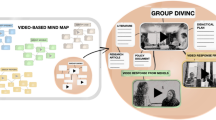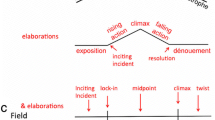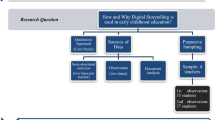Abstract
This study focusses on high school students’ written discourse about their experiences in a dynamic interactive digital environment in which functions were represented in one dimension, as dynagraphs, that are digital artifacts in which the independent variable can be acted upon and its movement causes the variation of the dependent variable. After the introduction of the notion of Dynamic Interactive Mediators within the theory of Commognition, we analyze and classify students’ written productions describing their experience with the dynagraphs. We present this classification as a tool of analysis that allows us to gain insight into how their writing reflects the temporal and dynamic dimensions of their experience with the dynagraphs. This tool is used to analyze 11 excerpts; finally, epistemological, cognitive and didactic implications of this tool are discussed.














Similar content being viewed by others
Notes
We use “DynaGraph” to refer to the original constructions described in the literature and used by Goldenberg, Lewis and O’Keefe, and “dynagraph” for the constructions used in this study.
In Sfard’s words (2008): “Thus, just as zoology, chemistry, and history can be defined as discourses about animals, chemical substances, and past communities, respectively, so can mathematics be described as a discourse about mathematical objects, such as numbers, functions, sets, and geometrical shapes. The simplicity of this claim is misleading, though, because the notion of mathematical object, unlike that of an animal or chemical substance, is notoriously elusive” (p. 129).
There is a “1” written on the far right of the screen.
References
Baccaglini-Frank, A., & Mariotti, M. A. (2010). Generating conjectures in dynamic geometry: The maintaining dragging model. International Journal of Computers for Mathematical Learning, 15(3), 225–253.
Carlson, M. P. (1998). A cross-sectional investigation of the development of the function concept. In A. H. Schoenfeld, J. Kaput, & E. Dubinsky (Eds.), Research in collegiate mathematics education. III. CBMS issues in mathematics education (pp. 114–162). Providence: American Mathematical Society.
Carlson, M. P. & Oehrtman, M. (2005). Key aspects of knowing and learning the concept of function. Research Sampler 9. MAA Notes.
Carlson, M. P. Jacobs, S., Coe, E., Larsen, S., & Hsu, E. (2002). Applying covariational reasoning while modeling dynamic events: A framework and a study. Journal for Research in Mathematics Education, 33(5), 352–378.
Colacicco, G., Lisarelli, G., & Antonini, S. (2017). Funzioni e grafici in ambienti digitali dinamici. Didattica della Matematica: dalla ricerca alle pratiche d’aula, 2, 7–25.
Falcade, R., Laborde, C., & Mariotti, M. A. (2007). Approaching functions: Cabri tools as instruments of semiotic mediation. Educational Studies in Mathematics, 66(3), 317–333.
Goldenberg, E. P., Lewis, P., & O’Keefe, J. (1992). Dynamic representation and the development of an understanding of functions. In G. Harel & E. Dubinsky (Eds.), The Concept of Function: Aspects of Epistemology and Pedagogy, 25. MAA Notes.
Healy, L., & Sinclair, N. (2007). If this is your mathematics, what are your stories? International Journal of Computers for Mathematics Learning, 12(1), 3–21.
Kaput, J. (1992). Patterns in students' formalization of quantitative patterns. In G. Harel & E. Dubinsky (Eds.), The concept of function: Aspects of epistemology and pedagogy, 25. Washington D.C.: MAA.
Lavie, I., Steiner, A., & Sfard, A. (2018). Routines we live by: From ritual to exploration. Educational Studies in Mathematics, 1–24.
Lisarelli, G. (2017). Exploiting potentials of dynamic representations of functions with parallel axes. In Proceedings of the 13thinternational conference on Technology in Mathematics Teaching (Vol. 1, pp. 144–150). Lyon: ICTMT.
Lisarelli, G. (2018). How dragging mediates discourse about functions. In E. Bergqvist, M. Österholm, C. Granberg, & L. Sumpter (Eds.), Proceedings of the 42nd conference of the IGPME (Vol. 3, pp. 323–330). Umeå: PME.
Lisarelli, G., Antonini, S., & Baccaglini-Frank, A. (in press). Capturing ‘time’: Characteristics of students’ written discourse on dynagraphs. In U. T. Jankvist, M. van den Heuvel–Panhuizen, & M. Veldhuis (Eds.), Proceedings of the 11thCongress of the European Society for Research in Mathematics Education. Utrecht: Freundenthal Group & Freundenthal Institute, Utrecht University and ERME.
Mason, J., & Pimm, D. (1984). Generic examples: Seeing the general in the particular. Educational Studies in Mathematics, 15(3), 277–289.
Monk, S., & Nemirovsky, R. (1994). The case of Dan: Student construction of a functional situation through visual attributes. In E. Dubinsky, A. H. Schoenfeld, & J. Kaput (Eds.), Research in collegiate mathematics education. I. CBMS issues in mathematics education (pp. 139–168). Providence: American Mathematical Society.
Ng, O. (2016). Comparing calculus communication across static and dynamic environments using a multimodal approach. Digital Experiences in Mathematics Education, 2(2), 115–141.
Sfard, A. (2008). Thinking as communicating: Human development, the growth of discourses, and mathematizing. Cambridge: Cambridge University Press.
Sinclair, N., Healy, L., & Reis Sales, C. (2009). Time for telling stories: Narrative thinking with dynamic geometry. Zentralblatt für Didaktik der Mathematik, 41(4), 441–452.
Thompson, P. W. (1994). Images of rate and operational understanding of the fundamental theorem of calculus. Educational Studies in Mathematics, 26, 229–274.
Acknowledgements
We thank Nathalie Sinclair for her support in developing the activities described in this paper, and for all the fruitful conversations she has engaged in with us, together with David Pimm. This study has been partially supported by Gruppo Nazionale per le Strutture Algebriche, Geometriche e le loro Applicazioni (GNSAGA) of the Italian Istituto Nazionale di Alta Matematica “Francesco Severi”.
Author information
Authors and Affiliations
Corresponding author
Ethics declarations
Conflict of Interest
On behalf of all authors, the corresponding author states that there is no conflicts of interest.
Additional information
Publisher’s Note
Springer Nature remains neutral with regard to jurisdictional claims in published maps and institutional affiliations.
Appendix
Appendix
Below we provide screenshots of the 7 dynagraphs that we referred to in this study:


Rights and permissions
About this article
Cite this article
Antonini, S., Baccaglini-Frank, A. & Lisarelli, G. From Experiences in a Dynamic Environment to Written Narratives on Functions. Digit Exp Math Educ 6, 1–29 (2020). https://doi.org/10.1007/s40751-019-00054-3
Published:
Issue Date:
DOI: https://doi.org/10.1007/s40751-019-00054-3




